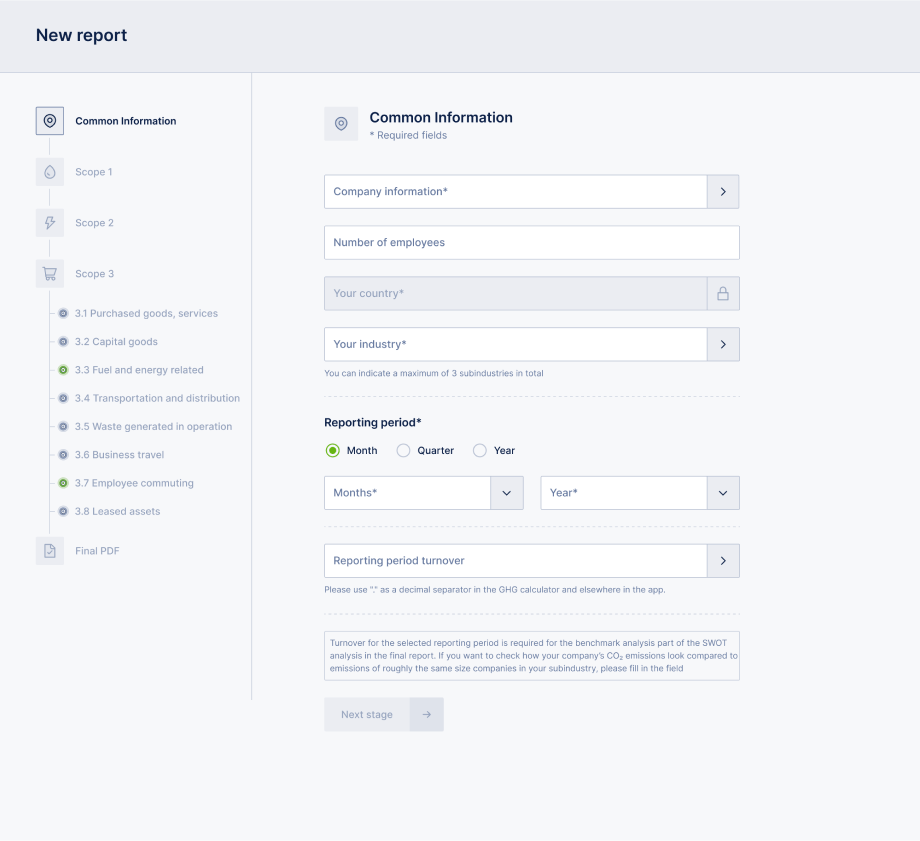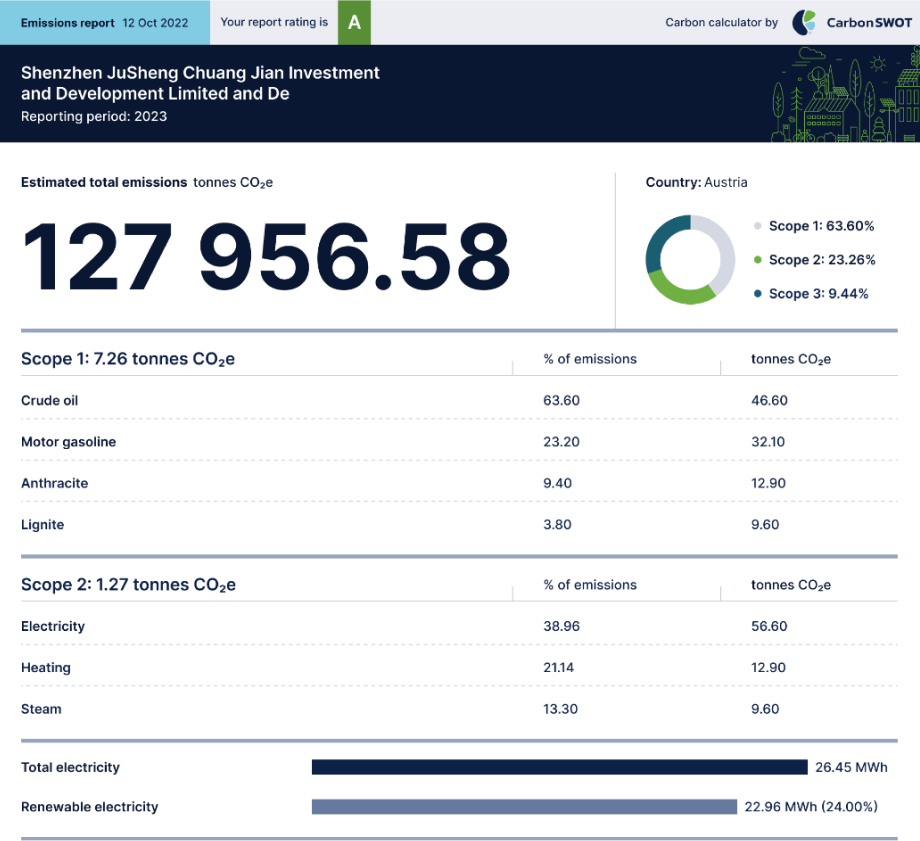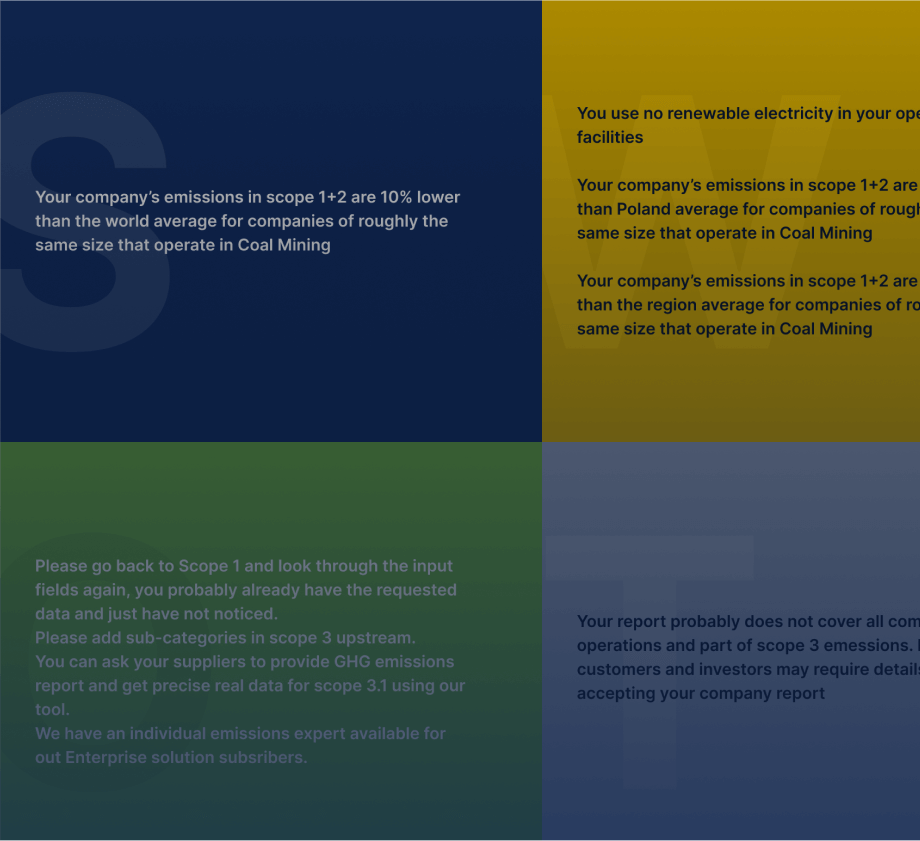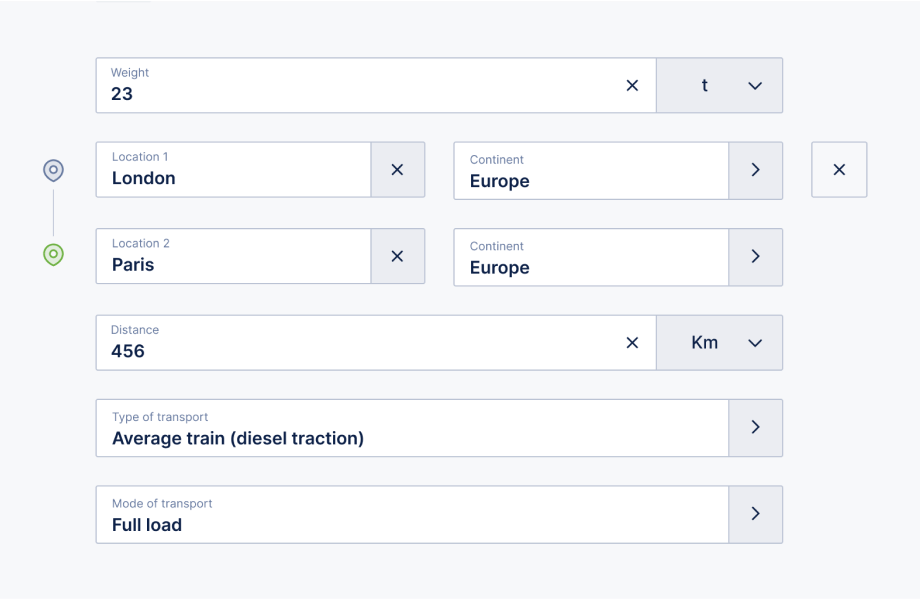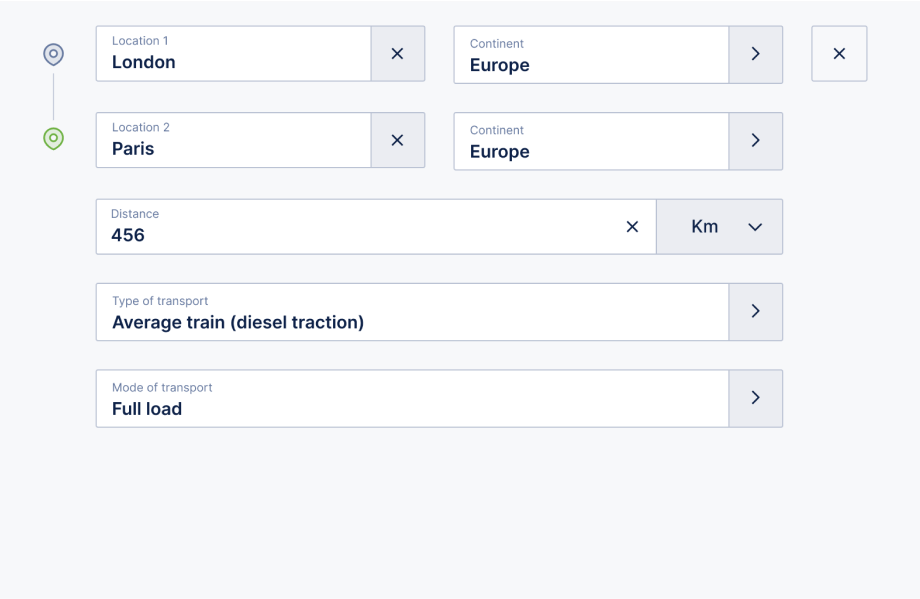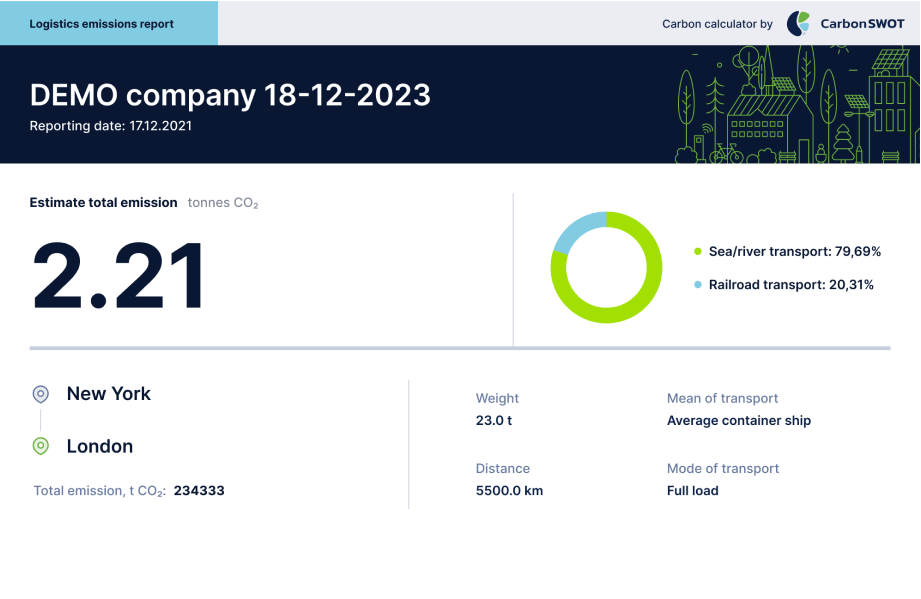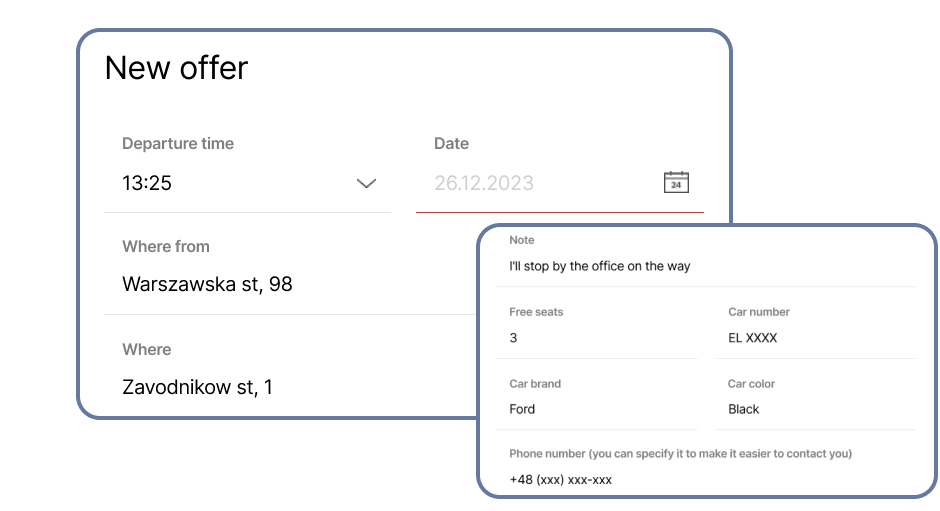Solutions
Solutions
Company GHG Emissions Calculator
CarbonSWOT is a powerful greenhouse gasses (GHG) emissions calculator designed to help you measure and manage your company’s carbon footprint. The user-friendly tool provides a simple and efficient way to quantify GHG emissions across various activities, allowing you to identify key areas for improvement in your business’ environmental impact.
Our tool is fully compliant with all existing climate care regulations like the Greenhouse Gas Protocol. And we constantly monitor any changes in the legal field to immediately accommodate. This means that you can safely share our reports with all interested parties, including authorities.
Whether you’re looking to enhance sustainability efforts, or strive to meet carbon reduction goals, CarbonSWOT offers a straightforward solution for understanding and managing your contribution to climate change. Start tracking and mitigating your carbon footprint today with CarbonSWOT’s intuitive GHG emissions calculator.
Start a trial
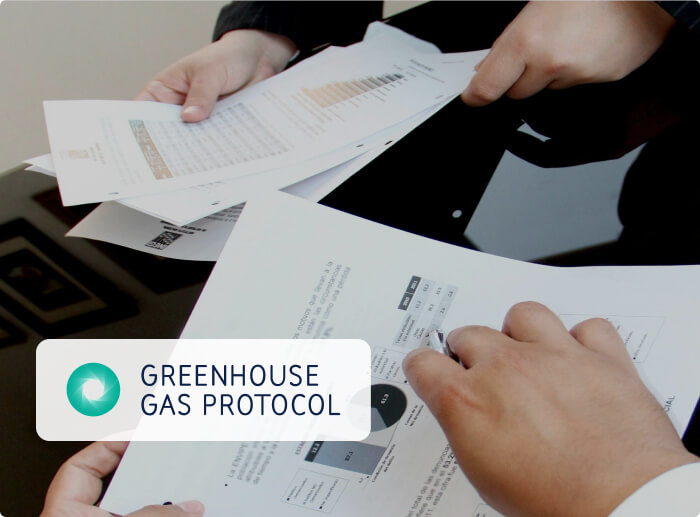
Logistics GHG Emissions Calculator
GHG emissions in logistics primarily come from the burning of fossil fuels in various means of transportation, such as trucks, ships, trains, and planes. The most common greenhouse gasses emitted in this area include carbon dioxide (CO2), methane (CH4), and nitrous oxide (N2O).
CarbonSWOT’ Logistics GHG Emissions Calculator will give you an insight into how sustainable your transportation is. It works under a Well to Wheels approach and takes currently the biggest on the market amount of factors into account. All with the aim to provide you with maximally detailed information into the carbon footprint of your logistics.

Our breakdown feature will also pinpoint the “dirtiest” segments in your routes. Thus, you will be able to tackle them precisely instead of addressing an entire itinerary, if everything else is within the norms.
Event GHG Emissions Calculator
A CarbonSWOT’s Event GHG Emissions Calculator will help you measure an event’s environmental impact. But first, why would you do this?
Measuring events’ emissions, you can:
Demonstrate your climate care strategy
Support the promotion of your CO2 efficient or CO2 neutral product(s)
Inspire and motivate your vendors to follow your GHG reduction approach
Involve employees in your sustainability initiatives and attract top talents
Show you innovation and leadership in ESG area to your customers
01. Measure
Select a calculation method
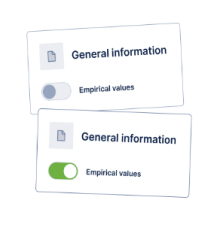
Input all required data according to the chosen method
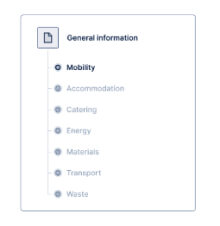
Engage your employees and external participants for applicable sections
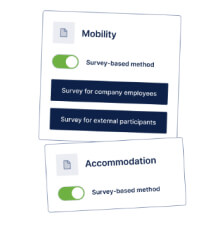
Get a report with AI-generated reduction measures
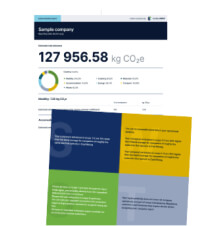
02. Reduce
Implement reduction measures and reduce your event CO2 footprint

03. Offset
Offset the rest of CO2 footprint by purchasing high quality carbon credits
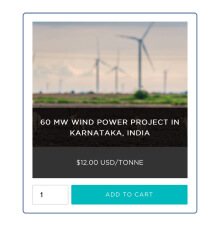
Сalculate
Ride Sharing Solution
Make your employee commuting more environmentally friendly.
We created a solution to help staff at medium and large enterprises better cooperate on traveling to and from work.
With it, your employees will be able to:
01
See the available rides
02
Apply for suitable ones
03
Сreate own rides
Using our ride sharing drives a number of benefits. Not only does it help reduce emissions and economize on fuel. It also facilitates communication between your staff. Sharing rides, your workers get to know each other better and make new contacts, enlarging their professional networks. Ultimately, this all positively impacts your corporate culture.
The solution is highly adaptable, so be sure it’ll accommodate your every need.
Carbon Offsetting Program
Experts at CarbonSWOT will select reliable offset programs, tailored for your business needs and region.

Carbon offsetting is a practice aimed at compensating for greenhouse gas (GHG) emissions in one area by investing in projects that reduce or remove an equivalent amount elsewhere. The goal is to achieve a net-zero carbon footprint by balancing emissions with actions that counteract or offset them. This is often done through the purchase of carbon credits.
A carbon credit, also known as a carbon offset or Verified Emission Reduction (VER), is a tradable certificate that represents the reduction, removal, or avoidance of one metric ton of carbon dioxide equivalent (CO2e) emissions. The concept is based on the idea that emissions reduction or removal activities can generate credits, which can then be sold or traded on the carbon market. Carbon credits are a key component of carbon offsetting initiatives.
The examples of carbon offsetting initiatives at CarbonSWOT
Companies purchase carbon offsets for several reasons, all of which contribute to their broader sustainability goals and commitments. Here are some of the key ones:
Achieving Carbon Neutrality
One of the primary reasons why companies purchase carbon offsets is — as mentioned—achieving carbon neutrality or a net-zero carbon footprint. By investing in projects that reduce or remove an equivalent amount of greenhouse gas emissions, companies can offset the emissions associated with their operations.
Meeting Sustainability Targets
Many companies set ambitious sustainability targets, which often include carbon emissions reduction goals. Carbon offsetting provides a way for them to make progress toward these goals, especially when immediate and complete emissions reduction is challenging.
Addressing Residual Emissions
Even with efforts to improve energy efficiency and adopt renewable energy sources, there may still be some emissions that are hard to eliminate entirely. Carbon offsets offer a way to address these residual emissions, contributing to an overall reduction in a company’s carbon footprint.
Compliance with Regulations and Standards
In some regions and industries, there are regulatory requirements or standards related to carbon emissions. Purchasing carbon offsets can help comply with these requirements and demonstrate a commitment to environmental responsibility.
Enhancing Corporate Reputation
Companies often invest in carbon offsets as part of their corporate social responsibility (CSR) initiatives. Demonstrating a commitment to environmental sustainability enhances their reputation, positively impacting their relationships with customers, investors, and other stakeholders.
Supporting Renewable Energy and Conservation Projects
Carbon offset projects are often associated with renewable energy (such as wind, solar, and hydropower) or conservation initiatives (reforestation and afforestation). Purchasing carbon offsets provides financial support for these projects, contributing to the transition to a low-carbon economy and biodiversity conservation.
Risk Mitigation
Climate change poses risks to businesses, including supply chain disruptions, extreme weather events, and regulatory changes. By investing in carbon offsets and supporting projects that address climate-related challenges, companies can contribute to risk mitigation and long-term business resilience.
Consumer and Investor Expectations
Consumers and investors increasingly expect companies to demonstrate environmental responsibility. Purchasing carbon offsets aligns with these expectations, signaling a commitment to sustainability and influencing consumer and investor perceptions.
Innovation and Leadership
Companies that proactively invest in carbon offsets demonstrate innovation and leadership in sustainable business practices. This can set them apart from competitors and position them as industry leaders in addressing climate change.
Global Initiatives and Partnerships
Participation in global initiatives like the Science-Based Targets Initiative (SBTi) or partnerships with environmental organizations may drive companies to invest in carbon offsets. These initiatives often encourage them to address their entire value chain’s emissions.
While carbon offsets can be a valuable tool in achieving carbon neutrality, it’s essential for companies to prioritize direct emissions reduction through energy efficiency measures, renewable energy adoption, and sustainable practices. Carbon offsetting should be seen as a complementary strategy within a broader sustainability framework.
If you need help in choosing an efficient offset program, we are here to assist. CarbonSWOT’s key priority is choosing high-quality offset projects with clear environmental benefits, as it’s crucial for the credibility and effectiveness of the offsetting efforts.

